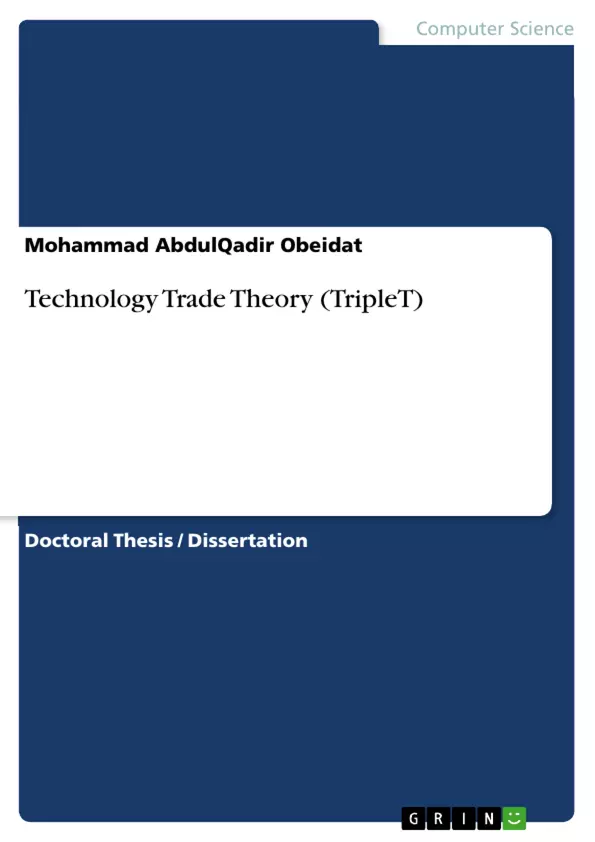Even though cloud computing is one of the hottest growth areas in the field of IT today, the existing body of literature related to cloud computing remains surprisingly small. The few research studies extant in the area have primarily focused on two broad areas, including: the technical implications of implementing cloud computing solutions, and the impact of cloud computing adoption by individual and organizational users. The behavioral aspects of cloud computing adoption, and especially using adoption models as a theoretical basis, remain least studied and most misunderstood. Moreover, existing models have been tested and used to gauge the behavior intention to adopt technology from a single perspective.
Accordingly, this study proposes a new model for evaluating technology adoption, with specific reference to cloud computing adoption – the Technology Trade Theory model. This model is derived from the synthesis of the Technology Acceptance Model and the Social Exchange Theory. The Triple T model proposes that technology acceptance is the result of a trade process. The purpose of this trade is to maximize advantages and minimize disadvantages. Prospective adopters will weigh the potential advantages and disadvantages of the technology and will only adopt the technology when its advantages outweigh its disadvantages.
Data is collected using a panel study administered to a sample of middle and top level IT managers. Relationships between the variables are assessed using the Pearson product moment correlation coefficient. Significance is tested by means of paired two-tailed tests.
Even though the study validates most of the relationships between variables in the TAM model, it still finds that the TAM model has less predictive ability. Since the proposed Triple T model addresses many of the weaknesses in the TAM model, the study proposes it to be a better model.
The proposed Triple T model also finds that a single advantage may outweigh numerous disadvantages or that a single disadvantage may outweigh numerous advantages during the adoption process and therefore executive decisions to adopt technology are often driven by just one advantage or disadvantage to the exclusion of all the others. These findings suggest that substantial improvement in the prediction of technology adoption intention is possible when previous models are integrated with the Social Exchange Theory.
Inhaltsverzeichnis (Table of Contents)
- Abstract
- Dedication
- Acknowledgement
- Chapter 1: Introduction
- 1.1: Introduction
- 1.2: Background
- 1.3: Problem Statement
- 1.4: Research Questions
- 1.5: Research Objectives
- 1.6: Scope of the Study
- 1.7: Significance of the Study
- 1.8: Organization of the Study
- Chapter 2: Literature Review
- 2.1: Introduction
- 2.2: Cloud Computing
- 2.3: Technology Adoption
- 2.4: Technology Acceptance Model
- 2.5: Social Exchange Theory
- 2.6: Cloud Computing Adoption Models
- 2.7: The Triple-T Model
- 2.8: Empirical Studies on Cloud Computing Adoption
- 2.9: Summary
- Chapter 3: Research Methodology
- 3.1: Introduction
- 3.2: Research Design
- 3.3: Population and Sample
- 3.4: Data Collection
- 3.5: Data Analysis
- 3.6: Summary
- Chapter 4: Findings and Discussion
- 4.1: Introduction
- 4.2: Descriptive Statistics
- 4.3: Correlation Analysis
- 4.4: Regression Analysis
- 4.5: Testing the Triple-T Model
- 4.6: Discussion of Findings
- 4.7: Summary
- Chapter 5: Conclusion and Recommendations
- 5.1: Introduction
- 5.2: Summary of Findings
- 5.3: Contributions of the Study
- 5.4: Limitations of the Study
- 5.5: Recommendations for Future Research
- 5.6: Conclusion
- References
- Appendix
Zielsetzung und Themenschwerpunkte (Objectives and Key Themes)
This dissertation explores the factors that influence the adoption of cloud computing initiatives by information technology executives. The study aims to develop a comprehensive model for evaluating technology adoption, specifically focusing on cloud computing. The research utilizes the Technology Acceptance Model (TAM) and the Social Exchange Theory to create a new model, the Technology Trade Theory (Triple-T), which emphasizes the trade-off process involved in technology adoption. The study investigates the relationships between various factors influencing cloud computing adoption and tests the predictive power of the proposed Triple-T model. Key themes explored in the dissertation include:- Factors affecting cloud computing adoption
- Technology adoption models and their application to cloud computing
- The Triple-T model as a framework for understanding technology adoption
- The role of perceived advantages and disadvantages in technology adoption decisions
- The impact of social exchange on technology adoption
Zusammenfassung der Kapitel (Chapter Summaries)
- Chapter 1: Introduction: This chapter introduces the research topic, provides background information on cloud computing, and outlines the problem statement, research questions, objectives, scope, significance, and organization of the study.
- Chapter 2: Literature Review: This chapter reviews existing literature on cloud computing, technology adoption, the Technology Acceptance Model, Social Exchange Theory, and cloud computing adoption models. It also presents the Triple-T model and discusses previous empirical studies on cloud computing adoption.
- Chapter 3: Research Methodology: This chapter details the research design, population, sample, data collection methods, and data analysis techniques employed in the study.
- Chapter 4: Findings and Discussion: This chapter presents the findings of the study, including descriptive statistics, correlation analysis, regression analysis, and the testing of the Triple-T model. It also discusses the implications of the findings.
Schlüsselwörter (Keywords)
This dissertation focuses on the adoption of cloud computing by IT executives. Key terms and concepts explored include cloud computing, technology adoption, Technology Acceptance Model (TAM), Social Exchange Theory, Technology Trade Theory (Triple-T), perceived advantages and disadvantages, perceived usefulness, perceived ease of use, social influence, trust, risk, and security. The research investigates the factors affecting adoption decisions, the predictive power of different models, and the importance of considering both individual and organizational perspectives.- Citation du texte
- Mohammad AbdulQadir Obeidat (Auteur), 2013, Technology Trade Theory (TripleT), Munich, GRIN Verlag, https://www.grin.com/document/321748



